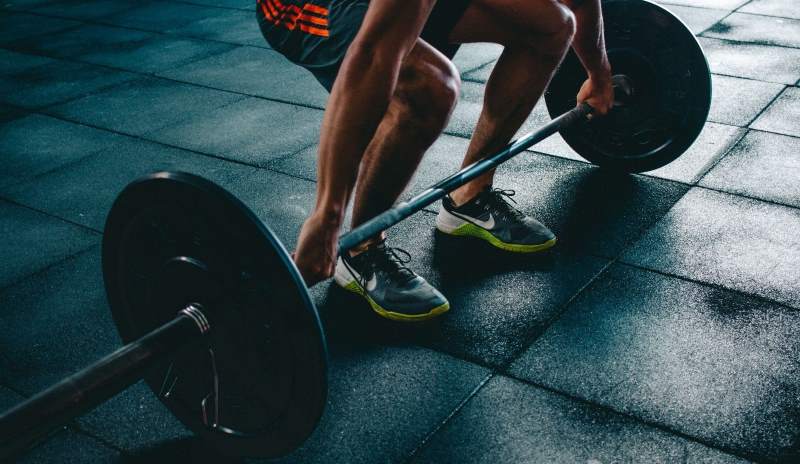As the saying goes, everyone has to start somewhere. All those guys and girls in the best shape of their lives were in the exact same position at some point in their lives.
There are so many websites, articles and videos telling you what exercises you must be doing for the best results. However, this information overload can sometimes put beginners off from working out.
Here is a definitive list of the best muscle gain exercises for beginners.
Compound Exercises For Beginners
Without a doubt, the best exercises for beginners are with compound exercises. These use more than one muscle during the movement. We recommend doing compound exercises because they are more in line with everyday movement patterns.
They will help beginners get stronger and grow more muscle mass than isolation exercises, which only train muscle group at a time.
Other benefits of compound exercise training include giving the body a full workout, an improvement in balance and reaction time and, with correct form, reduce the risk of injury.
Every workout should be including at least one of these exercises.
Here are the basic compound exercises needed in a beginner workout plan:
Bench Press
The bench press requires the chest muscles for the primary movement, with the shoulders and triceps used as the secondary muscles.
This exercise can be used with barbells or dumbells but this article will focus on using a barbell.
To perform the exercise, lie flat on a bench with shoulders pressed against the bench and feet firmly on the ground. Grip the bar at around shoulder-width with an overhand grip.
From here, push the bar off the rack and hold it in the air above the cener of the chest.
Once in position, lower the bar down to the mid-chest position. Ensure your elbows lower in a straight line and are pointing out at a 45-degree angle.
Actively think about the tension in the chest as the bar comes down.
Lower the bar until it touches your chest. Once here, push the weight back to the starting position while squeezing the chest muscles.
Squats
Squats are the best exercise for developing core strength and leg muscle mass. Every pro athlete or fitness enthusiast will incorporate squats into their workout. First-time gym goers should do the same.
Here is how to do a squat.
To begin the exercise, place a barbell in the squat rack just below shoulder height. Grip the bar just past shoulder-width.
Dip under the bar and rest it on your posterior deltoids at the base of the neck. From here, push up from the legs and take a step back from the rack, balancing the bar simultaneously.
Spread your feet at around shoulder-width and with your toes pointing slightly outwards.
Descend with the hips moving backwards. Do not lower with the intention of just bending at the knee. This will allow the squat to go deeper and put a lot less strain on the knees.
Aim to squat down to at least knee height. For optimal muscle contraction and better growth, squat as deep as you can.
From here, accelerate upwards, tensing the legs while the exercise continues back to the starting position.
The key to squats is the back position. It should be kept in a neutral or slightly arched position throughout the entire movement. Avoid rounding in the lower back to prevent injury.
For improving explosive power, squat down slowly and accelerate upwards quickly. This will also help you jump higher.
Deadlift
The deadlift is one of the hardest compound exercises to perform but is also one of the most effective in building muscle for beginners.
Deadlifts are best performed with a barbell but dumbbells can be just as good. This article will focus on the barbell variant.
Here is how to do a deadlift.
To start the exercise, place your feet at shoulder-width with your toes underneath the bar. They should remain flat on the ground throughout the movement.
Squat down, bend the knees and, with one hand, grasp the bar overhand and with the other, underhand. Keep the head in a neutral position to prevent injury to the spine.
Now for the movement:
Lift the bar up with the legs to knee height, using your hips first to keep the bar moving in a fluid, straight line. Your arms should remain straight during the lift.
From here, raise the bar by activating the back muscles. Do not pull it up with your arms. The bar should gently graze over the knees as it rises upwards.
Reverse the movement back down to the ground.
Similarly to the squat, a straight back is fundamental to the entire exercise. This will prevent injury going forward and ensure maximum gains.
Pull-Ups
The final exercise on this list is pull-ups. It requires very little equipment to perform but is excellent for building upper body strength and muscle. All that’s needed is a bar that’s strong enough.
Here is how to do a pull-up.
First, stand beneath the bar/rail with your feet shoulder-width apart. From here, use an overhand grip to hold the bar. This targets the upper back and latissimus dorsi (lats), using the arms and shoulders as the secondary muscles.
On the other hand, an underhand grip changes the primary muscle group to the biceps.
Once the grip is in place, hang from the bar and cross your legs to ease swinging.
Pull upwards until your chin reaches the bar while squeezing the back muscles. Keep the body in a straight line during the pulling motion.
Lower the weight back down to the starting position and lock the arms to complete.
Recovery
After a workout, it’s vital that the body is refuelled with food or a muscle mass supplement. Recovery is just important as the time spent working out.
Muscles only grow if the damage is repaired so do not forget this crucial step.




